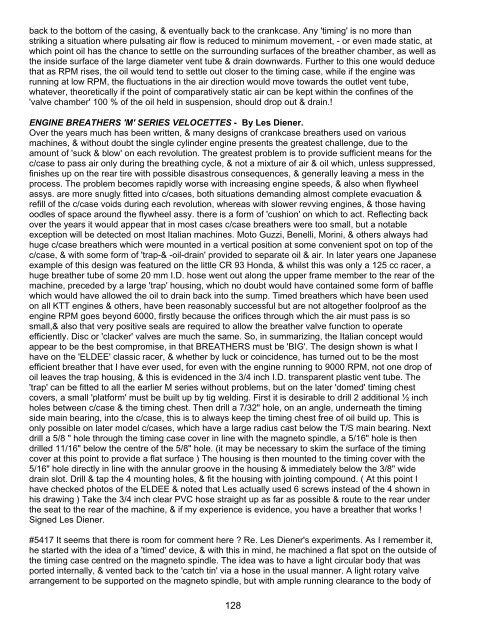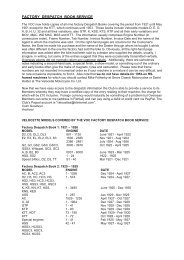The Knowledge - Velocette Owners Club
The Knowledge - Velocette Owners Club
The Knowledge - Velocette Owners Club
Create successful ePaper yourself
Turn your PDF publications into a flip-book with our unique Google optimized e-Paper software.
ack to the bottom of the casing, & eventually back to the crankcase. Any 'timing' is no more than<br />
striking a situation where pulsating air flow is reduced to minimum movement, - or even made static, at<br />
which point oil has the chance to settle on the surrounding surfaces of the breather chamber, as well as<br />
the inside surface of the large diameter vent tube & drain downwards. Further to this one would deduce<br />
that as RPM rises, the oil would tend to settle out closer to the timing case, while if the engine was<br />
running at low RPM, the fluctuations in the air direction would move towards the outlet vent tube,<br />
whatever, theoretically if the point of comparatively static air can be kept within the confines of the<br />
'valve chamber' 100 % of the oil held in suspension, should drop out & drain.!<br />
ENGINE BREATHERS 'M' SERIES VELOCETTES - By Les Diener.<br />
Over the years much has been written, & many designs of crankcase breathers used on various<br />
machines, & without doubt the single cylinder engine presents the greatest challenge, due to the<br />
amount of 'suck & blow' on each revolution. <strong>The</strong> greatest problem is to provide sufficient means for the<br />
c/case to pass air only during the breathing cycle, & not a mixture of air & oil which, unless suppressed,<br />
finishes up on the rear tire with possible disastrous consequences, & generally leaving a mess in the<br />
process. <strong>The</strong> problem becomes rapidly worse with increasing engine speeds, & also when flywheel<br />
assys. are more snugly fitted into c/cases, both situations demanding almost complete evacuation &<br />
refill of the c/case voids during each revolution, whereas with slower revving engines, & those having<br />
oodles of space around the flywheel assy. there is a form of 'cushion' on which to act. Reflecting back<br />
over the years it would appear that in most cases c/case breathers were too small, but a notable<br />
exception will be detected on most Italian machines. Moto Guzzi, Benelli, Morini, & others always had<br />
huge c/case breathers which were mounted in a vertical position at some convenient spot on top of the<br />
c/case, & with some form of 'trap-& -oil-drain' provided to separate oil & air. In later years one Japanese<br />
example of this design was featured on the little CR 93 Honda, & whilst this was only a 125 cc racer, a<br />
huge breather tube of some 20 mm I.D. hose went out along the upper frame member to the rear of the<br />
machine, preceded by a large 'trap' housing, which no doubt would have contained some form of baffle<br />
which would have allowed the oil to drain back into the sump. Timed breathers which have been used<br />
on all KTT engines & others, have been reasonably successful but are not altogether foolproof as the<br />
engine RPM goes beyond 6000, firstly because the orifices through which the air must pass is so<br />
small,& also that very positive seals are required to allow the breather valve function to operate<br />
efficiently. Disc or 'clacker' valves are much the same. So, in summarizing, the Italian concept would<br />
appear to be the best compromise, in that BREATHERS must be 'BIG'. <strong>The</strong> design shown is what I<br />
have on the 'ELDEE' classic racer, & whether by luck or coincidence, has turned out to be the most<br />
efficient breather that I have ever used, for even with the engine running to 9000 RPM, not one drop of<br />
oil leaves the trap housing, & this is evidenced in the 3/4 inch I.D. transparent plastic vent tube. <strong>The</strong><br />
'trap' can be fitted to all the earlier M series without problems, but on the later 'domed' timing chest<br />
covers, a small 'platform' must be built up by tig welding. First it is desirable to drill 2 additional ½ inch<br />
holes between c/case & the timing chest. <strong>The</strong>n drill a 7/32" hole, on an angle, underneath the timing<br />
side main bearing, into the c/case, this is to always keep the timing chest free of oil build up. This is<br />
only possible on later model c/cases, which have a large radius cast below the T/S main bearing. Next<br />
drill a 5/8 " hole through the timing case cover in line with the magneto spindle, a 5/16" hole is then<br />
drilled 11/16" below the centre of the 5/8" hole. (it may be necessary to skim the surface of the timing<br />
cover at this point to provide a flat surface ) <strong>The</strong> housing is then mounted to the timing cover with the<br />
5/16" hole directly in line with the annular groove in the housing & immediately below the 3/8" wide<br />
drain slot. Drill & tap the 4 mounting holes, & fit the housing with jointing compound. ( At this point I<br />
have checked photos of the ELDEE & noted that Les actually used 6 screws instead of the 4 shown in<br />
his drawing ) Take the 3/4 inch clear PVC hose straight up as far as possible & route to the rear under<br />
the seat to the rear of the machine, & if my experience is evidence, you have a breather that works !<br />
Signed Les Diener.<br />
#5417 It seems that there is room for comment here ? Re. Les Diener's experiments. As I remember it,<br />
he started with the idea of a 'timed' device, & with this in mind, he machined a flat spot on the outside of<br />
the timing case centred on the magneto spindle. <strong>The</strong> idea was to have a light circular body that was<br />
ported internally, & vented back to the 'catch tin' via a hose in the usual manner. A light rotary valve<br />
arrangement to be supported on the magneto spindle, but with ample running clearance to the body of<br />
128





